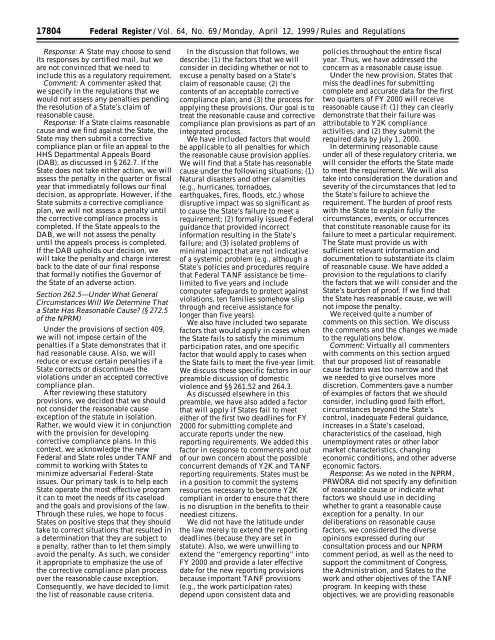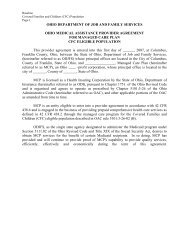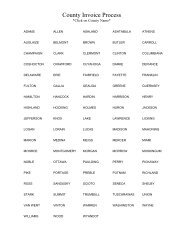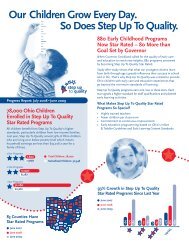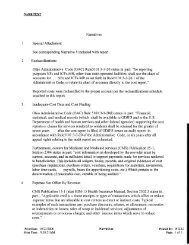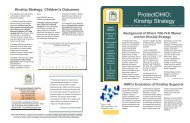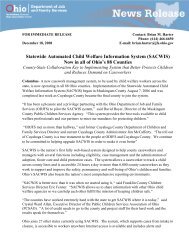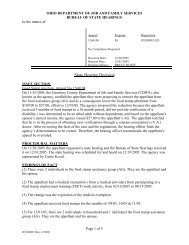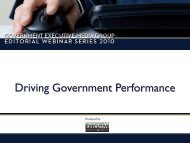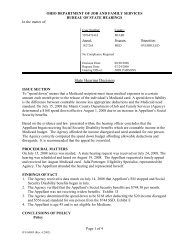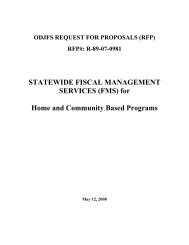Final TANF Rule as published in the Federal Register 4/12/1999
Final TANF Rule as published in the Federal Register 4/12/1999
Final TANF Rule as published in the Federal Register 4/12/1999
Create successful ePaper yourself
Turn your PDF publications into a flip-book with our unique Google optimized e-Paper software.
17804 <strong>Federal</strong> <strong>Register</strong> / Vol. 64, No. 69 / Monday, April <strong>12</strong>, <strong>1999</strong> / <strong>Rule</strong>s and Regulations<br />
Response: A State may choose to send<br />
its responses by certified mail, but we<br />
are not conv<strong>in</strong>ced that we need to<br />
<strong>in</strong>clude this <strong>as</strong> a regulatory requirement.<br />
Comment: A commenter <strong>as</strong>ked that<br />
we specify <strong>in</strong> <strong>the</strong> regulations that we<br />
would not <strong>as</strong>sess any penalties pend<strong>in</strong>g<br />
<strong>the</strong> resolution of a State’s claim of<br />
re<strong>as</strong>onable cause.<br />
Response: If a State claims re<strong>as</strong>onable<br />
cause and we f<strong>in</strong>d aga<strong>in</strong>st <strong>the</strong> State, <strong>the</strong><br />
State may <strong>the</strong>n submit a corrective<br />
compliance plan or file an appeal to <strong>the</strong><br />
HHS Departmental Appeals Board<br />
(DAB), <strong>as</strong> discussed <strong>in</strong> § 262.7. If <strong>the</strong><br />
State does not take ei<strong>the</strong>r action, we will<br />
<strong>as</strong>sess <strong>the</strong> penalty <strong>in</strong> <strong>the</strong> quarter or fiscal<br />
year that immediately follows our f<strong>in</strong>al<br />
decision, <strong>as</strong> appropriate. However, if <strong>the</strong><br />
State submits a corrective compliance<br />
plan, we will not <strong>as</strong>sess a penalty until<br />
<strong>the</strong> corrective compliance process is<br />
completed. If <strong>the</strong> State appeals to <strong>the</strong><br />
DAB, we will not <strong>as</strong>sess <strong>the</strong> penalty<br />
until <strong>the</strong> appeals process is completed.<br />
If <strong>the</strong> DAB upholds our decision, we<br />
will take <strong>the</strong> penalty and charge <strong>in</strong>terest<br />
back to <strong>the</strong> date of our f<strong>in</strong>al response<br />
that formally notifies <strong>the</strong> Governor of<br />
<strong>the</strong> State of an adverse action.<br />
Section 262.5—Under What General<br />
Circumstances Will We Determ<strong>in</strong>e That<br />
a State H<strong>as</strong> Re<strong>as</strong>onable Cause? (§ 272.5<br />
of <strong>the</strong> NPRM)<br />
Under <strong>the</strong> provisions of section 409,<br />
we will not impose certa<strong>in</strong> of <strong>the</strong><br />
penalties if a State demonstrates that it<br />
had re<strong>as</strong>onable cause. Also, we will<br />
reduce or excuse certa<strong>in</strong> penalties if a<br />
State corrects or discont<strong>in</strong>ues <strong>the</strong><br />
violations under an accepted corrective<br />
compliance plan.<br />
After review<strong>in</strong>g <strong>the</strong>se statutory<br />
provisions, we decided that we should<br />
not consider <strong>the</strong> re<strong>as</strong>onable cause<br />
exception of <strong>the</strong> statute <strong>in</strong> isolation.<br />
Ra<strong>the</strong>r, we would view it <strong>in</strong> conjunction<br />
with <strong>the</strong> provision for develop<strong>in</strong>g<br />
corrective compliance plans. In this<br />
context, we acknowledge <strong>the</strong> new<br />
<strong>Federal</strong> and State roles under <strong>TANF</strong> and<br />
commit to work<strong>in</strong>g with States to<br />
m<strong>in</strong>imize adversarial <strong>Federal</strong>-State<br />
issues. Our primary t<strong>as</strong>k is to help each<br />
State operate <strong>the</strong> most effective program<br />
it can to meet <strong>the</strong> needs of its c<strong>as</strong>eload<br />
and <strong>the</strong> goals and provisions of <strong>the</strong> law.<br />
Through <strong>the</strong>se rules, we hope to focus<br />
States on positive steps that <strong>the</strong>y should<br />
take to correct situations that resulted <strong>in</strong><br />
a determ<strong>in</strong>ation that <strong>the</strong>y are subject to<br />
a penalty, ra<strong>the</strong>r than to let <strong>the</strong>m simply<br />
avoid <strong>the</strong> penalty. As such, we consider<br />
it appropriate to emph<strong>as</strong>ize <strong>the</strong> use of<br />
<strong>the</strong> corrective compliance plan process<br />
over <strong>the</strong> re<strong>as</strong>onable cause exception.<br />
Consequently, we have decided to limit<br />
<strong>the</strong> list of re<strong>as</strong>onable cause criteria.<br />
In <strong>the</strong> discussion that follows, we<br />
describe: (1) <strong>the</strong> factors that we will<br />
consider <strong>in</strong> decid<strong>in</strong>g whe<strong>the</strong>r or not to<br />
excuse a penalty b<strong>as</strong>ed on a State’s<br />
claim of re<strong>as</strong>onable cause; (2) <strong>the</strong><br />
contents of an acceptable corrective<br />
compliance plan; and (3) <strong>the</strong> process for<br />
apply<strong>in</strong>g <strong>the</strong>se provisions. Our goal is to<br />
treat <strong>the</strong> re<strong>as</strong>onable cause and corrective<br />
compliance plan provisions <strong>as</strong> part of an<br />
<strong>in</strong>tegrated process.<br />
We have <strong>in</strong>cluded factors that would<br />
be applicable to all penalties for which<br />
<strong>the</strong> re<strong>as</strong>onable cause provision applies.<br />
We will f<strong>in</strong>d that a State h<strong>as</strong> re<strong>as</strong>onable<br />
cause under <strong>the</strong> follow<strong>in</strong>g situations: (1)<br />
Natural dis<strong>as</strong>ters and o<strong>the</strong>r calamities<br />
(e.g., hurricanes, tornadoes,<br />
earthquakes, fires, floods, etc.) whose<br />
disruptive impact w<strong>as</strong> so significant <strong>as</strong><br />
to cause <strong>the</strong> State’s failure to meet a<br />
requirement; (2) formally issued <strong>Federal</strong><br />
guidance that provided <strong>in</strong>correct<br />
<strong>in</strong>formation result<strong>in</strong>g <strong>in</strong> <strong>the</strong> State’s<br />
failure; and (3) isolated problems of<br />
m<strong>in</strong>imal impact that are not <strong>in</strong>dicative<br />
of a systemic problem (e.g., although a<br />
State’s policies and procedures require<br />
that <strong>Federal</strong> <strong>TANF</strong> <strong>as</strong>sistance be timelimited<br />
to five years and <strong>in</strong>clude<br />
computer safeguards to protect aga<strong>in</strong>st<br />
violations, ten families somehow slip<br />
through and receive <strong>as</strong>sistance for<br />
longer than five years).<br />
We also have <strong>in</strong>cluded two separate<br />
factors that would apply <strong>in</strong> c<strong>as</strong>es when<br />
<strong>the</strong> State fails to satisfy <strong>the</strong> m<strong>in</strong>imum<br />
participation rates, and one specific<br />
factor that would apply to c<strong>as</strong>es when<br />
<strong>the</strong> State fails to meet <strong>the</strong> five-year limit.<br />
We discuss <strong>the</strong>se specific factors <strong>in</strong> our<br />
preamble discussion of domestic<br />
violence and §§ 261.52 and 264.3.<br />
As discussed elsewhere <strong>in</strong> this<br />
preamble, we have also added a factor<br />
that will apply if States fail to meet<br />
ei<strong>the</strong>r of <strong>the</strong> first two deadl<strong>in</strong>es for FY<br />
2000 for submitt<strong>in</strong>g complete and<br />
accurate reports under <strong>the</strong> new<br />
report<strong>in</strong>g requirements. We added this<br />
factor <strong>in</strong> response to comments and out<br />
of our own concern about <strong>the</strong> possible<br />
concurrent demands of Y2K and <strong>TANF</strong><br />
report<strong>in</strong>g requirements. States must be<br />
<strong>in</strong> a position to commit <strong>the</strong> systems<br />
resources necessary to become Y2K<br />
compliant <strong>in</strong> order to ensure that <strong>the</strong>re<br />
is no disruption <strong>in</strong> <strong>the</strong> benefits to <strong>the</strong>ir<br />
neediest citizens.<br />
We did not have <strong>the</strong> latitude under<br />
<strong>the</strong> law merely to extend <strong>the</strong> report<strong>in</strong>g<br />
deadl<strong>in</strong>es (because <strong>the</strong>y are set <strong>in</strong><br />
statute). Also, we were unwill<strong>in</strong>g to<br />
extend <strong>the</strong> ‘‘emergency report<strong>in</strong>g’’ <strong>in</strong>to<br />
FY 2000 and provide a later effective<br />
date for <strong>the</strong> new report<strong>in</strong>g provisions<br />
because important <strong>TANF</strong> provisions<br />
(e.g., <strong>the</strong> work participation rates)<br />
depend upon consistent data and<br />
policies throughout <strong>the</strong> entire fiscal<br />
year. Thus, we have addressed <strong>the</strong><br />
concern <strong>as</strong> a re<strong>as</strong>onable cause issue.<br />
Under <strong>the</strong> new provision, States that<br />
miss <strong>the</strong> deadl<strong>in</strong>es for submitt<strong>in</strong>g<br />
complete and accurate data for <strong>the</strong> first<br />
two quarters of FY 2000 will receive<br />
re<strong>as</strong>onable cause if: (1) <strong>the</strong>y can clearly<br />
demonstrate that <strong>the</strong>ir failure w<strong>as</strong><br />
attributable to Y2K compliance<br />
activities; and (2) <strong>the</strong>y submit <strong>the</strong><br />
required data by July 1, 2000.<br />
In determ<strong>in</strong><strong>in</strong>g re<strong>as</strong>onable cause<br />
under all of <strong>the</strong>se regulatory criteria, we<br />
will consider <strong>the</strong> efforts <strong>the</strong> State made<br />
to meet <strong>the</strong> requirement. We will also<br />
take <strong>in</strong>to consideration <strong>the</strong> duration and<br />
severity of <strong>the</strong> circumstances that led to<br />
<strong>the</strong> State’s failure to achieve <strong>the</strong><br />
requirement. The burden of proof rests<br />
with <strong>the</strong> State to expla<strong>in</strong> fully <strong>the</strong><br />
circumstances, events, or occurrences<br />
that constitute re<strong>as</strong>onable cause for its<br />
failure to meet a particular requirement.<br />
The State must provide us with<br />
sufficient relevant <strong>in</strong>formation and<br />
documentation to substantiate its claim<br />
of re<strong>as</strong>onable cause. We have added a<br />
provision to <strong>the</strong> regulations to clarify<br />
<strong>the</strong> factors that we will consider and <strong>the</strong><br />
State’s burden of proof. If we f<strong>in</strong>d that<br />
<strong>the</strong> State h<strong>as</strong> re<strong>as</strong>onable cause, we will<br />
not impose <strong>the</strong> penalty.<br />
We received quite a number of<br />
comments on this section. We discuss<br />
<strong>the</strong> comments and <strong>the</strong> changes we made<br />
to <strong>the</strong> regulations below.<br />
Comment: Virtually all commenters<br />
with comments on this section argued<br />
that our proposed list of re<strong>as</strong>onable<br />
cause factors w<strong>as</strong> too narrow and that<br />
we needed to give ourselves more<br />
discretion. Commenters gave a number<br />
of examples of factors that we should<br />
consider, <strong>in</strong>clud<strong>in</strong>g good faith effort,<br />
circumstances beyond <strong>the</strong> State’s<br />
control, <strong>in</strong>adequate <strong>Federal</strong> guidance,<br />
<strong>in</strong>cre<strong>as</strong>es <strong>in</strong> a State’s c<strong>as</strong>eload,<br />
characteristics of <strong>the</strong> c<strong>as</strong>eload, high<br />
unemployment rates or o<strong>the</strong>r labor<br />
market characteristics, chang<strong>in</strong>g<br />
economic conditions, and o<strong>the</strong>r adverse<br />
economic factors.<br />
Response: As we noted <strong>in</strong> <strong>the</strong> NPRM,<br />
PRWORA did not specify any def<strong>in</strong>ition<br />
of re<strong>as</strong>onable cause or <strong>in</strong>dicate what<br />
factors we should use <strong>in</strong> decid<strong>in</strong>g<br />
whe<strong>the</strong>r to grant a re<strong>as</strong>onable cause<br />
exception for a penalty. In our<br />
deliberations on re<strong>as</strong>onable cause<br />
factors, we considered <strong>the</strong> diverse<br />
op<strong>in</strong>ions expressed dur<strong>in</strong>g our<br />
consultation process and our NPRM<br />
comment period, <strong>as</strong> well <strong>as</strong> <strong>the</strong> need to<br />
support <strong>the</strong> commitment of Congress,<br />
<strong>the</strong> Adm<strong>in</strong>istration, and States to <strong>the</strong><br />
work and o<strong>the</strong>r objectives of <strong>the</strong> <strong>TANF</strong><br />
program. In keep<strong>in</strong>g with <strong>the</strong>se<br />
objectives, we are provid<strong>in</strong>g re<strong>as</strong>onable


